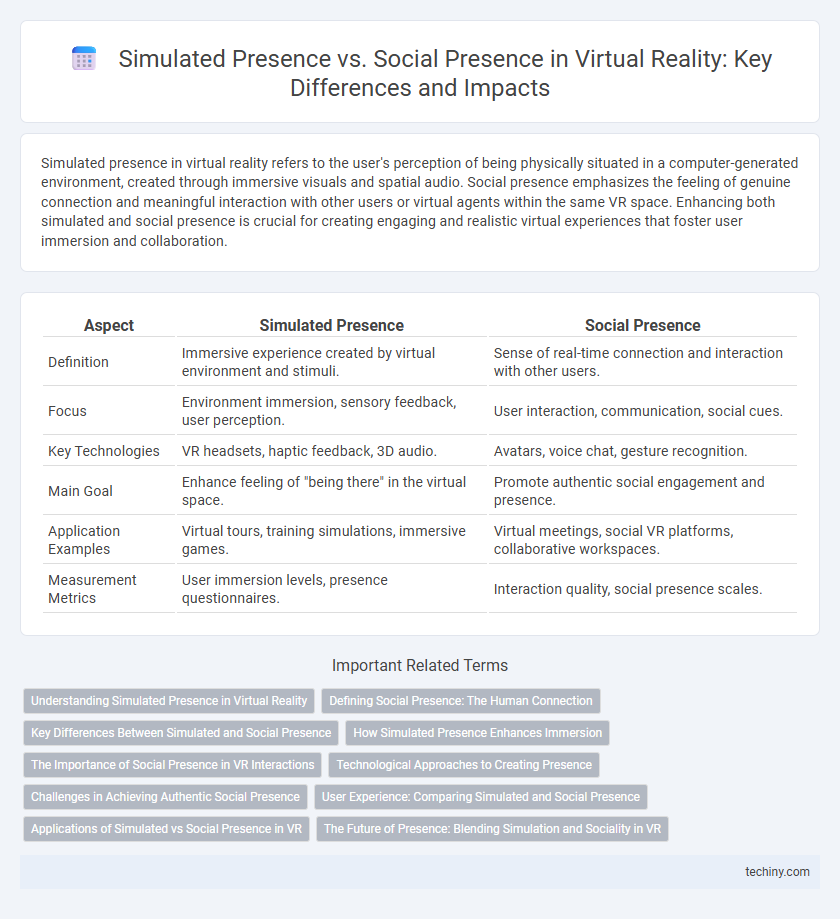Simulated presence in virtual reality refers to the user's perception of being physically situated in a computer-generated environment, created through immersive visuals and spatial audio. Social presence emphasizes the feeling of genuine connection and meaningful interaction with other users or virtual agents within the same VR space. Enhancing both simulated and social presence is crucial for creating engaging and realistic virtual experiences that foster user immersion and collaboration.
Table of Comparison
| Aspect | Simulated Presence | Social Presence |
|---|---|---|
| Definition | Immersive experience created by virtual environment and stimuli. | Sense of real-time connection and interaction with other users. |
| Focus | Environment immersion, sensory feedback, user perception. | User interaction, communication, social cues. |
| Key Technologies | VR headsets, haptic feedback, 3D audio. | Avatars, voice chat, gesture recognition. |
| Main Goal | Enhance feeling of "being there" in the virtual space. | Promote authentic social engagement and presence. |
| Application Examples | Virtual tours, training simulations, immersive games. | Virtual meetings, social VR platforms, collaborative workspaces. |
| Measurement Metrics | User immersion levels, presence questionnaires. | Interaction quality, social presence scales. |
Understanding Simulated Presence in Virtual Reality
Simulated presence in virtual reality refers to the user's perception of being physically situated within a virtual environment, created through sensory stimuli such as visual, auditory, and haptic feedback. This immersive experience relies on high-quality VR hardware, including head-mounted displays and motion tracking, to enhance the sense of spatial presence and realism. Understanding simulated presence is crucial for designing effective VR applications that foster user engagement and interaction without necessarily involving real social connections.
Defining Social Presence: The Human Connection
Social presence refers to the sense of being with others in a virtual environment, emphasizing emotional and interpersonal connections that mimic real-life interactions. It involves recognizing and responding to social cues, facial expressions, and body language within virtual reality to create authentic human connections. Simulated presence, by contrast, centers on the feeling of being physically located in a virtual space without necessarily fostering interpersonal engagement.
Key Differences Between Simulated and Social Presence
Simulated presence in virtual reality refers to the user's perception of being physically situated within a digital environment, emphasizing sensory immersion through visual, auditory, and haptic feedback. Social presence centers on the feeling of being with others in a virtual space, driven by interaction quality, avatar expressiveness, and real-time communication cues. Key differences include simulated presence prioritizing environmental realism, while social presence emphasizes interpersonal connectivity and collaborative engagement within VR experiences.
How Simulated Presence Enhances Immersion
Simulated presence in virtual reality creates a lifelike sensory experience through realistic audio-visual cues and haptic feedback, significantly enhancing user immersion by making the environment feel physically tangible. This deep sensory integration triggers stronger emotional and cognitive engagement compared to social presence alone, which emphasizes user interaction with others. Advances in technologies like spatial audio, high-resolution displays, and motion tracking amplify simulated presence, fostering a more convincing and absorbing virtual experience.
The Importance of Social Presence in VR Interactions
Social presence in virtual reality significantly enhances user engagement by creating a sense of real human interaction, which simulated presence alone cannot achieve. High social presence facilitates effective communication, emotional connection, and collaborative experiences within VR environments. Research indicates that VR platforms with advanced social presence capabilities improve user satisfaction and collective task performance.
Technological Approaches to Creating Presence
Technological approaches to creating presence in virtual reality emphasize simulated presence by using high-fidelity graphics, spatial audio, and haptic feedback to replicate real-world environments and interactions, enhancing user immersion. Social presence relies on avatar representation, real-time communication, and behavioral synchronization to foster a sense of co-presence with others within virtual spaces. Advanced techniques such as eye-tracking, motion capture, and AI-driven responsiveness further bridge the gap between simulated and social presence, creating more authentic and engaging VR experiences.
Challenges in Achieving Authentic Social Presence
Achieving authentic social presence in virtual reality faces challenges such as accurately replicating non-verbal cues, including facial expressions and body language, which are critical for genuine human interaction. Limited haptic feedback and latency issues disrupt seamless communication, reducing the sense of real-time connection. Overcoming these barriers requires advanced sensor technology and improved avatar realism to foster immersive, believable social experiences.
User Experience: Comparing Simulated and Social Presence
Simulated presence in virtual reality creates a controlled environment where users interact with AI-driven elements, enhancing immersion through realistic sensory feedback and environmental consistency. Social presence emphasizes real-time interaction with other users, fostering a sense of connection and collaboration that heightens emotional engagement and user satisfaction. Comparing these types of presence highlights that while simulated presence offers seamless experiential control, social presence drives community building and dynamic interpersonal experiences crucial for long-term user retention.
Applications of Simulated vs Social Presence in VR
Simulated presence in VR creates immersive environments with lifelike interactions, enhancing training simulations, therapeutic treatments, and solo gaming experiences by fostering a sense of physical space and engagement. Social presence emphasizes real-time interaction among multiple users, driving applications in virtual meetings, collaborative workspaces, and social platforms where authentic communication and shared experiences are crucial. Both forms of presence optimize user engagement but serve distinct purposes: simulated presence targets individual immersion, while social presence focuses on interpersonal connectivity within virtual environments.
The Future of Presence: Blending Simulation and Sociality in VR
Simulated presence in VR emphasizes lifelike environments and realistic interactions, while social presence prioritizes genuine emotional connections and co-presence among users. The future of presence lies in seamlessly blending these dimensions, leveraging advanced AI-driven avatars and multi-sensory feedback to create immersive yet socially rich experiences. Integrating simulation with authentic social cues enhances user engagement, fostering deeper collaboration and emotional resonance in virtual spaces.
Simulated presence vs Social presence Infographic

 techiny.com
techiny.com